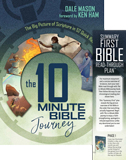The Power of Biblical Chronology
Chronological teaching is a proven way to address today’s chronic biblical illiteracy. So claims the author of this article, who taught Bible history in public schools for 13 years.
Before I became a full-time speaker and curriculum specialist at Answers in Genesis, I spent 13 years teaching Bible history in a public school. Yes, you read that correctly. I was one of over 2,000 teachers who had the privilege of teaching God’s Word in state schools around the United States—legally. This gave me a front-row seat to observe the rapid decline in biblical literacy in our culture. I also saw how easy it is to inspire young people’s interest in the Bible, if taught properly.
With each passing year, fewer students could answer the most basic questions like, “Where is Genesis? What are the gospels? What does 3:8 mean when it appears beside the word Exodus? What is sin?” Even students raised in church in the so-called buckle of the Bible Belt lacked a simple understanding of basic biblical principles. Surveys verify this trend.
While we may not be able to directly change our culture, we can change how we teach young people in our churches and homes. I’d like to share some lessons I learned from teaching these elective courses, which had such a powerful and life-changing impact on many students.
God’s Word is compelling on its own, if we just let it sink in.
The basic concept was simple. Teach the Bible from the beginning, in chronological order! That’s the ingredient that so many students with church backgrounds are missing, and it even helped unchurched students understand the Bible’s message. God’s Word is compelling on its own, if we just let it sink in.
Each year I taught through the Bible chronologically, covering the events in the order they actually took place. One school year was just enough time to give my students the big picture, a panoramic view of the biblical timeline so they could grasp where the major biblical characters and events fit within the history of the rest of the world. As we went through the Bible, I would also address the skeptical questions of this age (apologetics), showing how archaeology confirms the Bible time and again. This chronological approach was new to about 99% of my students, and it’s hard to overstate its potency.
Think about it. To many the Bible is a jumbled mess of stories with no tangible connection to the real world and no coherent flow or singular theme. Why? All they know are random tidbits they see on television, or if they attended church occasionally, the average Sunday school and main service offered no formal training in apologetics or understanding the Bible chronologically. One Sunday you might learn about Elijah in 1 Kings, the next Sunday a miracle by Jesus in the Gospel of John.
Unless a young person is determined to research on his own—and who really expects that?—none will learn the details about the chronology of biblical events and characters.
Why is this so critical? That’s how God revealed Himself, and that’s how God designed us to see the world—in sequential order! When we understand the biblical chronology and see the big picture of biblical history, the Bible comes alive! When we understand where the Tabernacle and priests fit, when David fought Goliath, who Elijah and Daniel were, the difference between the Exodus and the Exile, the birth of Christ and the church, and the historical order of the epistles, the Bible makes so much more sense! There is a flow, a logical sequence, an ordered cause and effect guided by a sovereign hand.
And through it all there is one singular theme—God’s plan for rescuing man through His only Son, Jesus Christ! Theologians call it the “scarlet thread.” The Old Testament points to His first coming, and the New Testament records His arrival and future return! It’s like the Bible and history have a single Author who knows what He’s talking about and will keep His promises to save His people. Imagine that!
In our day, the enemy is attacking biblical authority by attacking the Bible’s history. If the Bible’s history makes no logical sense, why trust what it says about salvation? Teaching the Bible chronologically, along with apologetics to show why we know the Bible is true, prepares Christian young people with the necessary big picture to recognize and warn against the errors of our day. When I was teaching churched and unchurched young people alike for those 13 years, I watched the wheels start turning in their minds as the Holy Spirit used a chronological approach to turn the lights on.
The basic progression I witnessed was something like this: “Wait, the Bible’s true? It gets history right? But if it’s right about the past, maybe it’s right about the future. Maybe it’s right about the present. Maybe it’s right about the state of my soul, and I need to bow my knee!” That’s the impact of showing that the Bible is real history, it connects to the real world, and it points the only real way to salvation!
5 Lessons from 13 Years in the Trenches
Good Teaching 101: Know Your Audience, Know Yourself, Know Your Subject—Recognize and address the specific needs of your students. Supplement your weaknesses and utilize your strengths while infusing your personality into the lessons. This makes your teaching authentic, which students quickly recognize and respond to. And of course study to handle the Word of truth rightly (2 Timothy 2:15).
Keep the Big Picture—Maybe the hardest part of teaching the Bible chronologically is determining which things you’re going to skip, skim, or highlight. Make your choices in light of the main goal: presenting a complete panoramic view of the Bible.
Connect the Dots—Be sure to demonstrate the cause and effect of biblical people and events to help the students catch the flow of biblical history. When this is done correctly, the Bible—all of it—makes sense!
Connect to the Real World—Show how the Bible is confirmed time and again by things like archaeology, geology, biology, and anthropology. Students need to see the Bible is not merely a story book of moral and spiritual truths. It’s a book that connects to real people, places, and events. This makes the Bible come alive! It also unleashes a powerful truth: you can trust the Bible when it talks about history, so you can trust it when it talks about salvation. It is the very Word of God.
Along the Way Point Out Jesus—In truth, the whole Bible is about God’s plan of redemption. It’s all about Jesus! The Old Testament points to Jesus and the New Testament is based on Jesus. And to the astute observer, this is just as obvious in the Old Testament as it is in the New. Be sure to show how Jesus and the gospel are present throughout the entire Bible. When the students see this, not only does the Bible make sense, they see it has one Author who knew what He was doing all along!
Answers Magazine
April–June 2016
How well do you know the views of modern creationists? Test your knowledge and then discover how Christians can effectively share the gospel with homosexuals.
Browse IssueRecommended Resources

Answers in Genesis is an apologetics ministry, dedicated to helping Christians defend their faith and proclaim the good news of Jesus Christ.
- Customer Service 800.778.3390
- Available Monday–Friday | 9 AM–5 PM ET
- © 2025 Answers in Genesis







